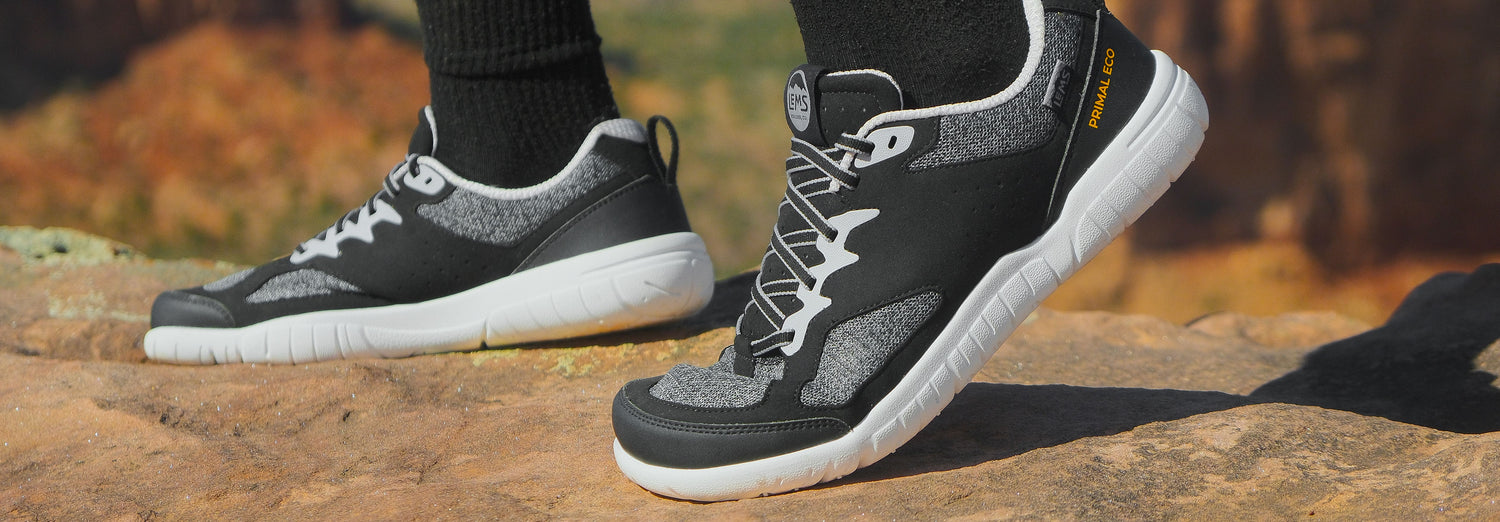Understanding Your Feet
Your feet are as unique as you are, and understanding their individual characteristics can help you choose the right footwear and prevent common hiking-related foot problems. There are three main foot types, each with its own characteristics and implications for hiking:
Neutral Feet: Neutral feet have a well-defined arch that is neither too high nor too low. When you walk, your footprint will show a distinct curve along the inside. Biomechanically efficient, neutral feet are less prone to overpronation or supination. You can wear a variety of footwear but may benefit from additional arch support for long hikes.
Flat Feet (Pes Planus): Flat feet have little to no arch, resulting in the entire sole of the foot making contact with the ground. Your footprint may show almost the entire sole. Flat feet are more prone to overpronation, where the foot rolls inward excessively. This can lead to issues like plantar fasciitis, shin splints, and knee pain. People with flat feet should look for hiking boots or shoes with good arch support and stability features to help prevent these problems.
High Arches (Pes Cavus): High arches have a pronounced arch that does not flatten much when bearing weight. Your footprint may show only the heel and ball of the foot, with a thin connection between the two. High arches are less effective at absorbing shock, which can lead to issues like stress fractures, ankle sprains, and calluses. Hikers with high arches should look for shoes with extra cushioning and flexibility to help absorb impact and reduce the risk of injury.
Identifying your foot type can help you choose the right hiking footwear and accessories to support your feet effectively. If you're unsure about your foot type, a podiatrist or foot specialist can provide a more detailed analysis and recommend appropriate footwear options.
Pre-Hike Foot Preparation
Breaking in new hiking footwear is crucial to prevent blisters and discomfort on the trail. Here are some tips for breaking in your new hiking boots or shoes:
-
Start Slow: Wear your new footwear for short periods initially, gradually increasing the duration as they start to feel more comfortable. This allows your feet to adjust to the new shoes without causing too much friction or pressure.
-
Wear Them Indoors: Wear your new hiking boots or shoes around the house to break them in. This will help soften the materials and allow them to mold to your feet more quickly. You can also wear them with hiking socks to ensure the proper fit.
-
Use Thick Socks: When breaking in your new footwear, wear thick hiking socks to cushion your feet and reduce friction. This can help prevent blisters and hot spots from forming.
-
Test Them on Short Hikes: Before embarking on a long hike, test your new footwear on shorter, less challenging hikes. This will give you a chance to assess their comfort and performance and make any necessary adjustments.
-
Address Hot Spots Immediately: If you feel any rubbing or discomfort while breaking in your new footwear, address it immediately. Apply moleskin or a blister prevention product to the affected area to reduce friction and prevent blisters from forming.
-
Consider Professional Fitting: If you're unsure about the fit of your new hiking boots or shoes, consider getting a professional fitting. A knowledgeable salesperson can help you find the right size and style for your foot type and hiking needs.
Pre-Hike Foot Preparation
Preparing your feet before hitting the trail is essential for a comfortable hiking experience. Here are some key steps to take:
-
Choosing the Right Hiking Footwear: Selecting the right footwear is crucial for foot health on the trail. Look for hiking boots or shoes that provide adequate support, cushioning, and protection for your foot type and the terrain you'll be hiking on.
-
Breaking in Your Footwear: Before embarking on a long hike, it's essential to break in your new hiking boots or shoes. Wear them around the house and on short walks to allow them to mold to your feet and soften the materials.
-
Selecting the Right Socks: The type of socks you wear can also impact your foot health on the trail. Choose moisture-wicking socks that provide cushioning and support. Avoid cotton socks, as they can retain moisture and increase the risk of blisters.
-
Foot Hygiene: Proper foot hygiene is essential for preventing blisters and fungal infections. Keep your feet clean and dry, especially between your toes. Consider using foot powder or anti-friction products to reduce moisture and friction.
-
Trimming Your Toenails: Trim your toenails straight across to prevent ingrown toenails. Long toenails can rub against the inside of your shoes, leading to discomfort and potential injury.
-
Stretching and Strengthening Exercises: Before your hike, perform some gentle stretching and strengthening exercises for your feet and ankles. This can help improve flexibility and reduce the risk of strains or sprains on the trail.
-
Checking Your Gear: Inspect your hiking boots or shoes, as well as your socks, for any signs of wear or damage. Replace any worn-out gear to ensure proper support and protection for your feet.
By taking these steps to prepare your feet before hiking, you can help prevent common foot problems and enjoy a more comfortable and enjoyable hiking experience.
During the Hike
While on the trail, it's essential to pay attention to your feet and take proactive steps to maintain their health. Here are some tips for caring for your feet during a hike:
-
Proper Footwear Adjustment: Throughout your hike, periodically check the fit of your hiking boots or shoes. Adjust the laces if necessary to ensure a snug but comfortable fit. Avoid overtightening, as this can restrict blood flow and lead to discomfort.
-
Addressing Hot Spots: If you feel a hot spot developing on your foot, stop and address it immediately. Apply moleskin or a blister prevention product to the affected area to reduce friction and prevent a blister from forming.
-
Managing Moisture: Moisture buildup can increase the risk of blisters and fungal infections. Take breaks to remove your socks and let your feet air out. Consider changing into a fresh pair of socks if yours are damp.
-
Staying Hydrated: Proper hydration is essential for foot health on the trail. Dehydration can lead to muscle cramps and stiffness, affecting your gait and increasing the risk of foot injuries. Drink plenty of water throughout your hike to stay hydrated.
-
Resting and Elevating Your Feet: If you start to feel fatigue or discomfort in your feet, take regular breaks to rest and elevate your feet. This can help reduce swelling and improve circulation, keeping your feet comfortable for the duration of your hike.
-
Inspecting Your Feet: Periodically stop and inspect your feet for any signs of blisters, cuts, or other injuries. Address any issues immediately to prevent them from worsening.
-
Maintaining Proper Posture: Proper posture can help reduce strain on your feet and lower limbs. Pay attention to your posture while hiking and make adjustments as needed to maintain a comfortable and efficient stride.
Post-Hike Foot Care and Advanced Tips
After a challenging hike, it's essential to give your feet some well-deserved care to prevent any lingering issues and prepare them for your next adventure. Here's how to care for your feet post-hike, along with some advanced foot care tips:
-
Clean and Dry Your Feet: Remove your hiking boots or shoes and gently wash your feet with mild soap and warm water. Pay special attention to areas prone to blisters or irritation. Pat your feet dry with a towel, ensuring they are completely dry.
-
Inspect Your Feet: Check your feet for any signs of blisters, cuts, or abrasions. If you notice any issues, clean the area thoroughly and apply an antiseptic ointment. Cover with a sterile dressing if needed.
-
Moisturize: Apply a moisturizing lotion or foot cream to keep your skin hydrated and prevent dryness and cracking. Avoid applying lotion between your toes, as this can increase the risk of fungal infections.
-
Elevate Your Feet: To reduce swelling and promote circulation, elevate your feet above heart level for 10-15 minutes. This can help reduce inflammation and promote faster recovery.
-
Stretch and Massage: Gently stretch your calf muscles and massage your feet to relieve tension and improve circulation. Use a tennis ball or a foot roller to roll under your feet, targeting sore spots.
-
Advanced Recovery Techniques: Consider using recovery tools such as compression socks or sleeves to improve circulation and reduce swelling. Ice packs or cold therapy can help reduce inflammation and soothe sore muscles and joints.
-
Monitor Your Feet: Keep an eye on any lingering foot issues, such as blisters or pain. If problems persist, consult a podiatrist or foot health professional for further evaluation and treatment.
-
Foot Soaks: Treat your feet to a soothing foot soak with Epsom salts or essential oils. This can help relax your muscles and soften any rough or calloused areas.
- Proper Nutrition: Maintain a balanced diet rich in vitamins and minerals to support overall foot health and recovery. Adequate hydration is also crucial for keeping your feet healthy and hydrated.
Conclusion
Caring for your feet is essential for a comfortable and enjoyable hiking experience. By understanding your foot type, choosing the right footwear, and practicing proper foot care techniques, you can prevent common foot problems and maintain foot health on the trail. Whether you're preparing for a day hike or a multi-day trek, taking care of your feet before, during, and after your hike is crucial.
Remember to listen to your body and address any foot issues promptly. If you experience persistent foot pain or discomfort, consult a podiatrist or foot health professional for proper diagnosis and treatment. With proper foot care, you can continue to explore the great outdoors with happy and healthy feet.

